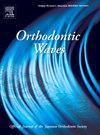非拔出和保留移位位置治疗右上犬齿和第一前磨牙完全移位和第二磨牙剪刀式咬合
IF 0.5
Q4 DENTISTRY, ORAL SURGERY & MEDICINE
引用次数: 1
摘要
摘要目的:本病例报告描述了一例骨骼I类错牙合、右上犬齿和第一前臼齿完全移位、第二臼齿被剪刀式咬合的患者,通过不拔出和保留移位的牙齿位置来成功治疗。病例:患者是一名10岁零2个月大的女孩,她被转诊到我们的诊所。在第一阶段治疗中,上颌和下颌第一磨牙的远端移动改善了牙齿拥挤。在第二阶段治疗中,对双侧第二磨牙的每一次剪刀式咬合进行治疗,并将犬齿和第一前磨牙对齐在移位位置。治疗结果:因此,她获得了良好的咬合,改善了咀嚼性下颌运动。在积极治疗三年后,使用可拆卸固定器的治疗结果稳定。结论:剪刀式咬合的正畸治疗可以显著改善咀嚼运动,从而提高咀嚼性能。此外,通过在不拔出的情况下保留移位位置对移位牙齿进行正畸治疗,可以获得令人满意的美学和功能最终结果,这意味着这可能是一种有效的治疗选择。本文章由计算机程序翻译,如有差异,请以英文原文为准。
Treatment of complete transposition of upper right canine and first premolar and scissors-bite on second molars by non-extraction and retention of the transposed positions
ABSTRACT Objective: This case report describes the successful treatment of a patient with a skeletal Class I malocclusion, complete transposition of the upper right canine and first premolar, and scissors-bite on the second molars, treated by non-extraction and retention of the transposed positions of the teeth. Case: The patient was a 10-year and 2-month-old girl, who was referred to our clinic. In Phase I treatment, dental crowding was improved by distal movement of the maxillary and mandibular first molars. In Phase II treatment, each scissors-bite on the bilateral second molar was treated and the canine and first premolar were aligned in the transposed position. Treatment results: Consequently, she acquired excellent occlusion and improved masticatory jaw movement. Three years after the active treatment, treatment results were stable with the use of removable retainers. Conclusion: Orthodontic treatment for scissors-bite may increase masticatory performance because it improves masticatory movement significantly. Additionally, orthodontic treatment of transposed teeth by retaining the transposed position without extraction could lead to satisfactory aesthetic and functional final results, which implies that it could be a valid treatment option.
求助全文
通过发布文献求助,成功后即可免费获取论文全文。
去求助
来源期刊

Orthodontic Waves
DENTISTRY, ORAL SURGERY & MEDICINE-
CiteScore
0.40
自引率
0.00%
发文量
0
期刊介绍:
Orthodontic Waves is the official publication of the Japanese Orthodontic Society. The aim of this journal is to foster the advancement of orthodontic research and practice. The journal seeks to publish original articles (i) definitive reports of wide interest to the orthodontic community, (ii) Case Reports and (iii) Short Communications. Research papers stand on the scientific basis of orthodontics. Clinical topics covered include all techniques and approaches to treatment planning. All submissions are subject to peer review.
 求助内容:
求助内容: 应助结果提醒方式:
应助结果提醒方式:


